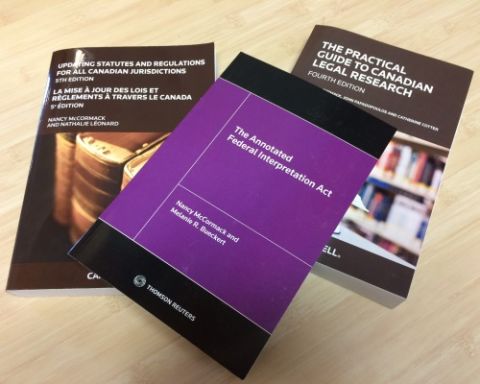
After almost two years of effort, Queen’s Law professor and librarian Nancy McCormack, along with co-author Melanie R. Bueckert, are seeing the fruits of their labour in print with Carswell’s publication of The Annotated Federal Interpretation Act. While the title may be prosaic, the book explores one of the most influential statutes in law: the Act that sets the rules, so to speak, for all other Acts.
“The Interpetation Act is an Act to help us interpret other Acts. It’s a statute about statutes. There are poetic phrases, like ‘law shall be considered as always speaking,’ but also some very concrete concepts that need to be explained for us to understand and interpret our laws,” McCormack explains.
“We need to resolve disputes, such as what happens when somebody says ‘You have a day to complete this action.’ It’s 3:52 in the afternoon. Do I have 24 hours, until 3:52 the next day? Or do days begin and end at midnight? What is a court going to do with these problems, and how does the Interpretation Act help? If a statute is repealed and replaced, what happens to the regulations under the first statute? Are they still in force? If a statute says ‘The Minister may do the following,’ does that strictly mean only the actual Minister? Or those working on his or her behalf – and if so, whom, and to what extent?”
These are the underpinnings of law that the Interpretation Act defines and clarifies. Since it exists as a document that defines the terms in many other Acts, its implications can be profound. “As an Act about other Acts, it applies to everything. From fisheries to criminal law, from copyright to tax, the Federal Interpretation Act affects all of our federal laws, and it applies both retroactively as well as forward.”
Why annotate it? As McCormack points out, there’s a need for the Interpretation Act to be, itself, interpreted through its implementation. “When people look at a statute they see its language, but may not understand how to interpret it,” she says. “Phrases in the Interpretation Act like ‘law shall be considered as always speaking’ are delightful, but you have to really look at case law to see what it actually means.”
Annotations not only serve to explain the Act through cases, but also to show how it has changed. “What ‘the law always speaking’ means is that the law is dynamic – a section of law implemented 100 years ago must be interpreted according to contemporary values and expectations,” McCormack says. “Annotated statutes look at how the courts deal with these issues; how they have applied these sections in the past, and how that application has changed. We expect change: we couldn’t have Victorian interpretations of the laws governing our modern lives in all situations. We look at old, and then new, case law to give lawyers and judges insight into how the law has been understood over time, and how they can approach the problems before them now.”
It’s a book that’s already seen demand from law professors across the country – including three professors who proposed a similar project to Carswell while McCormack and Bueckert were working on their version – and that will serve both lawyers and judges well in the courtroom.
“Reading all the case law behind the annotations was almost like taking a second degree itself,” McCormack says of the research process. “It was a lot of fun to work on, and I think it will be of great use to practitioners and scholars alike.”